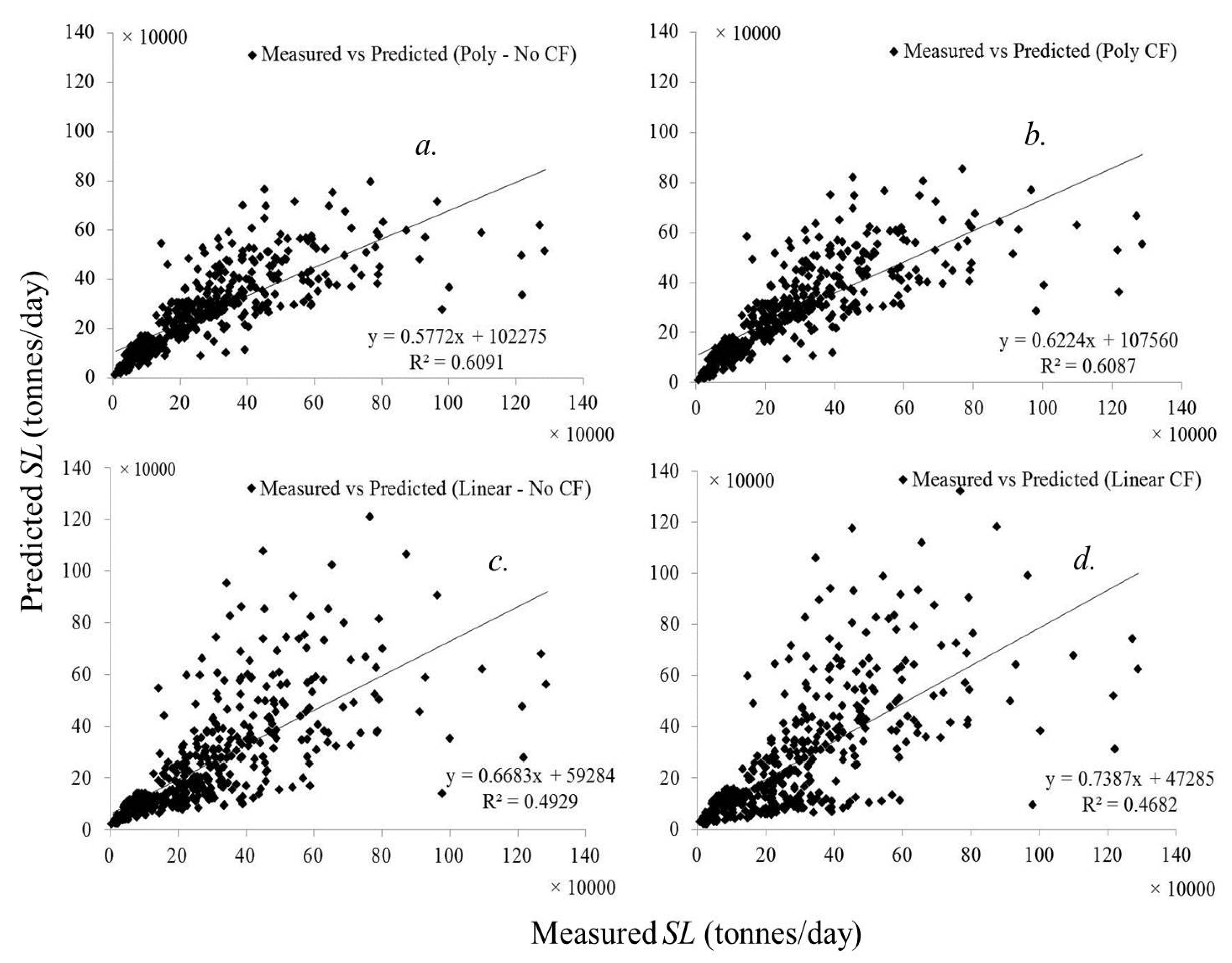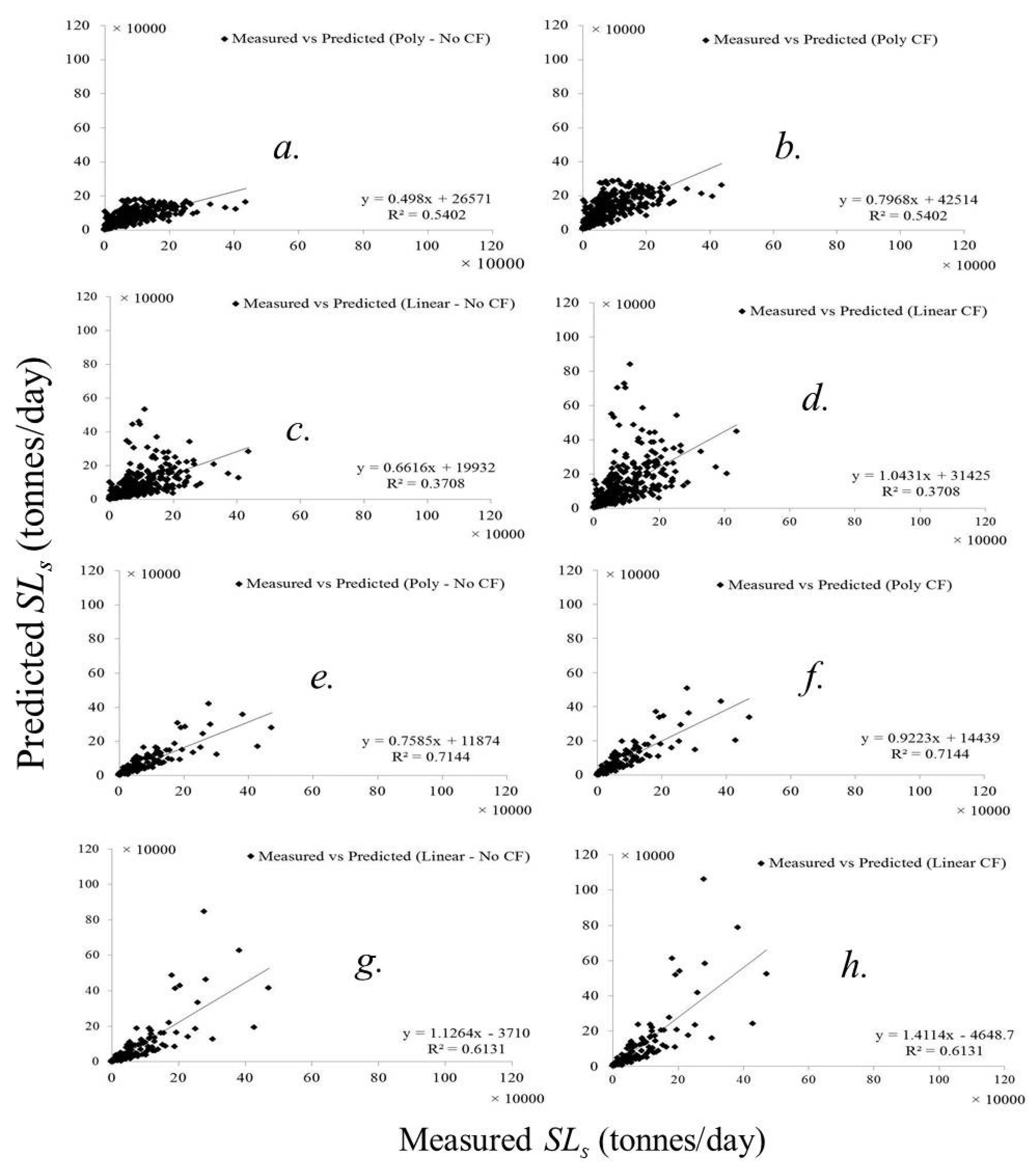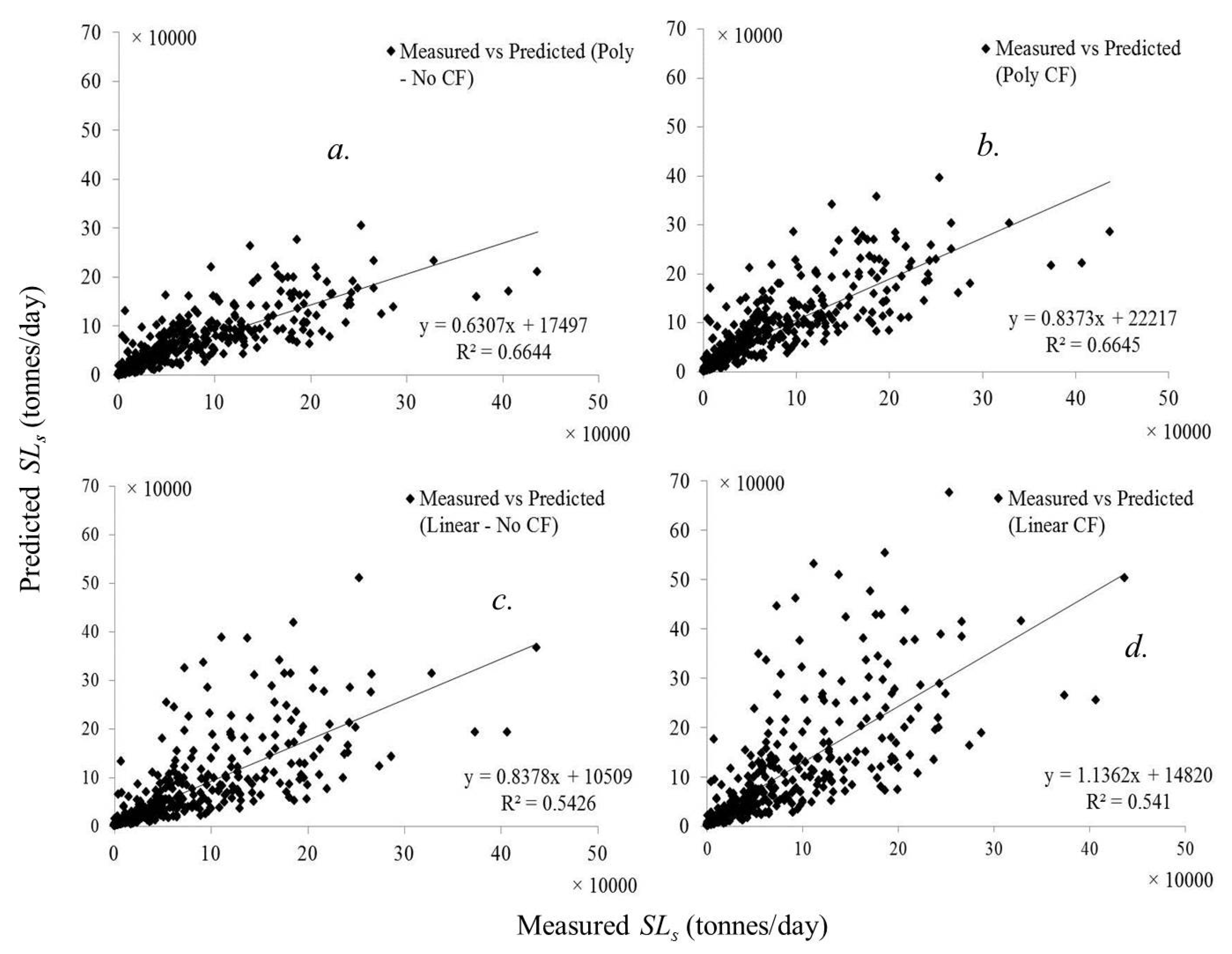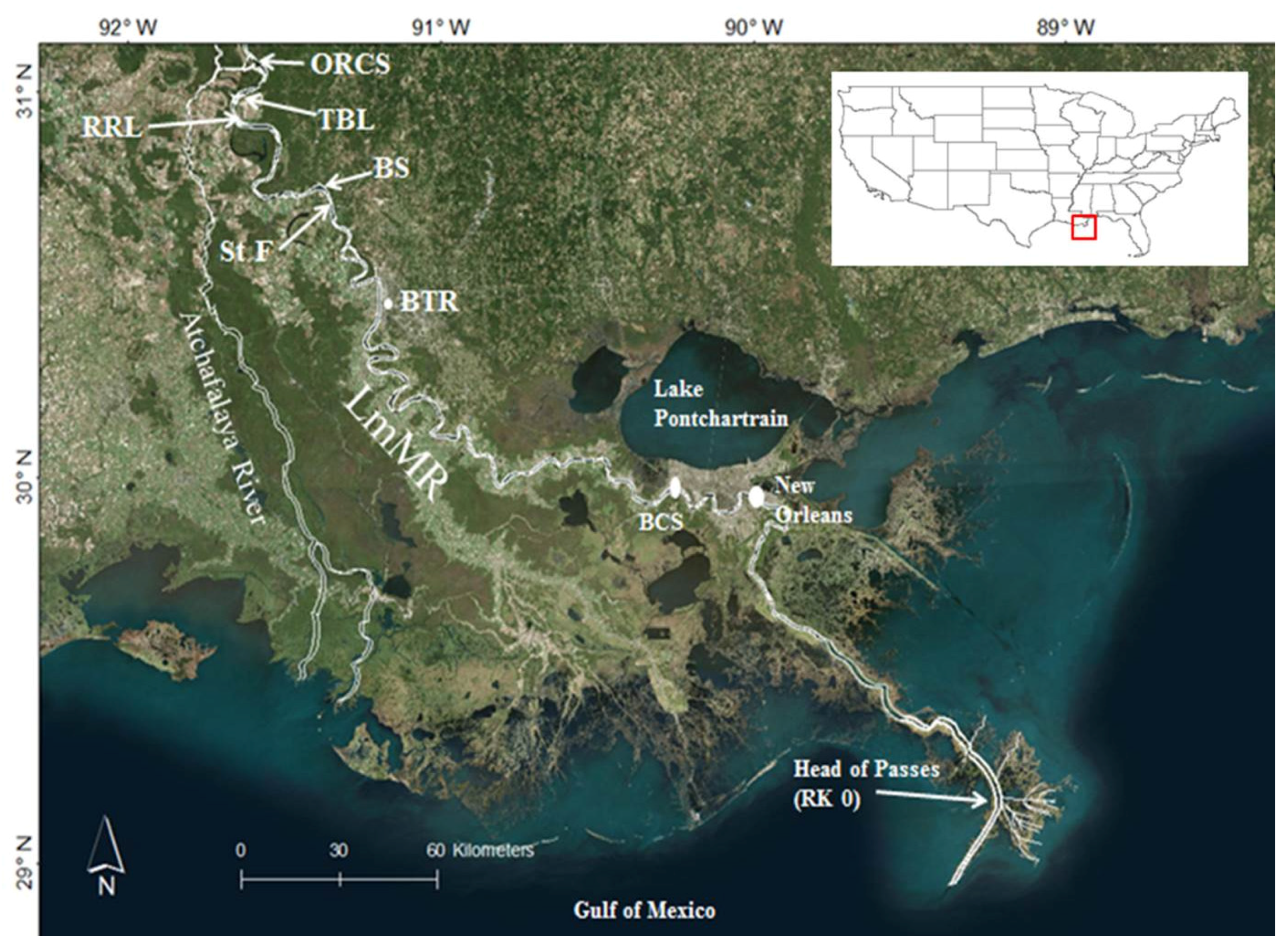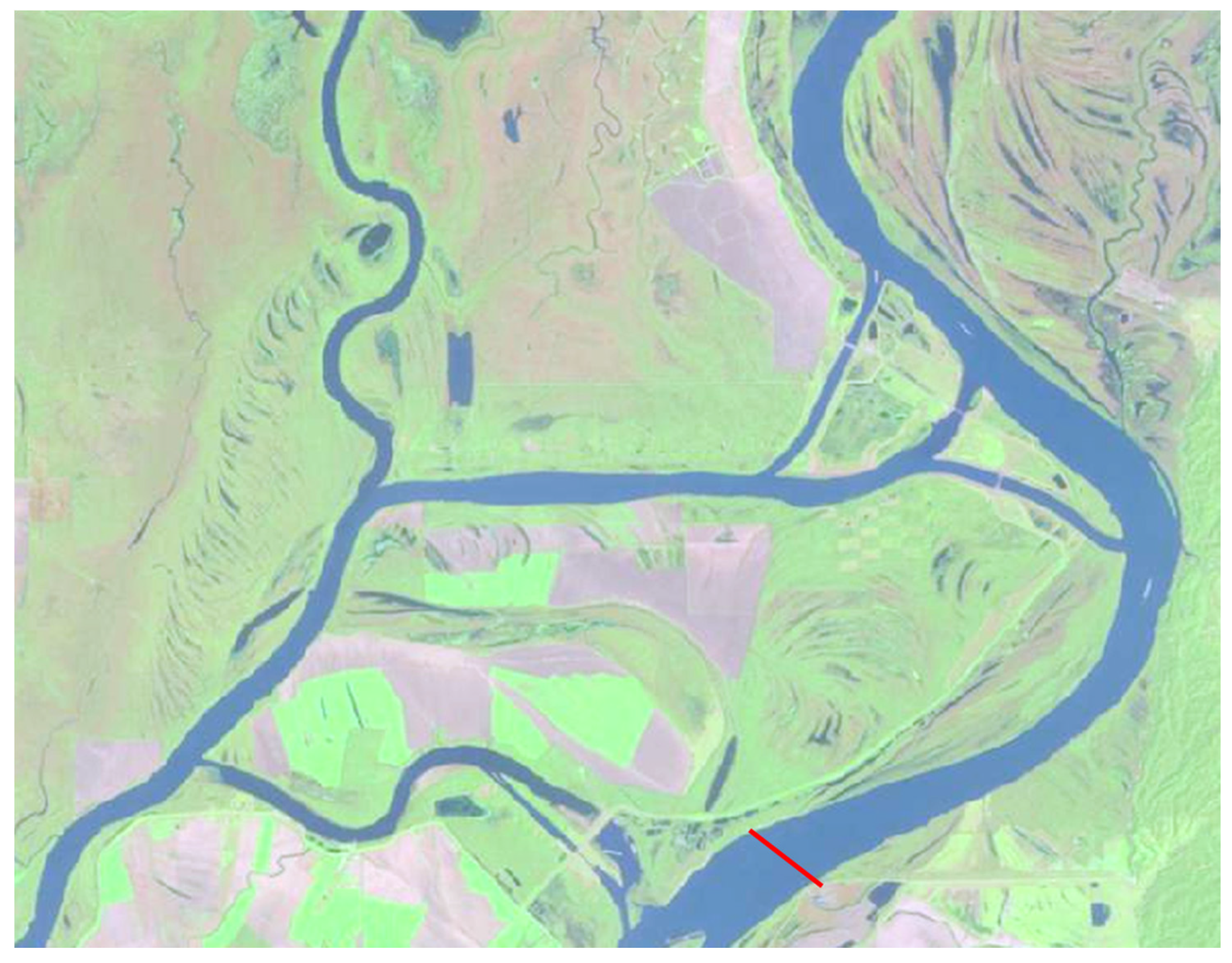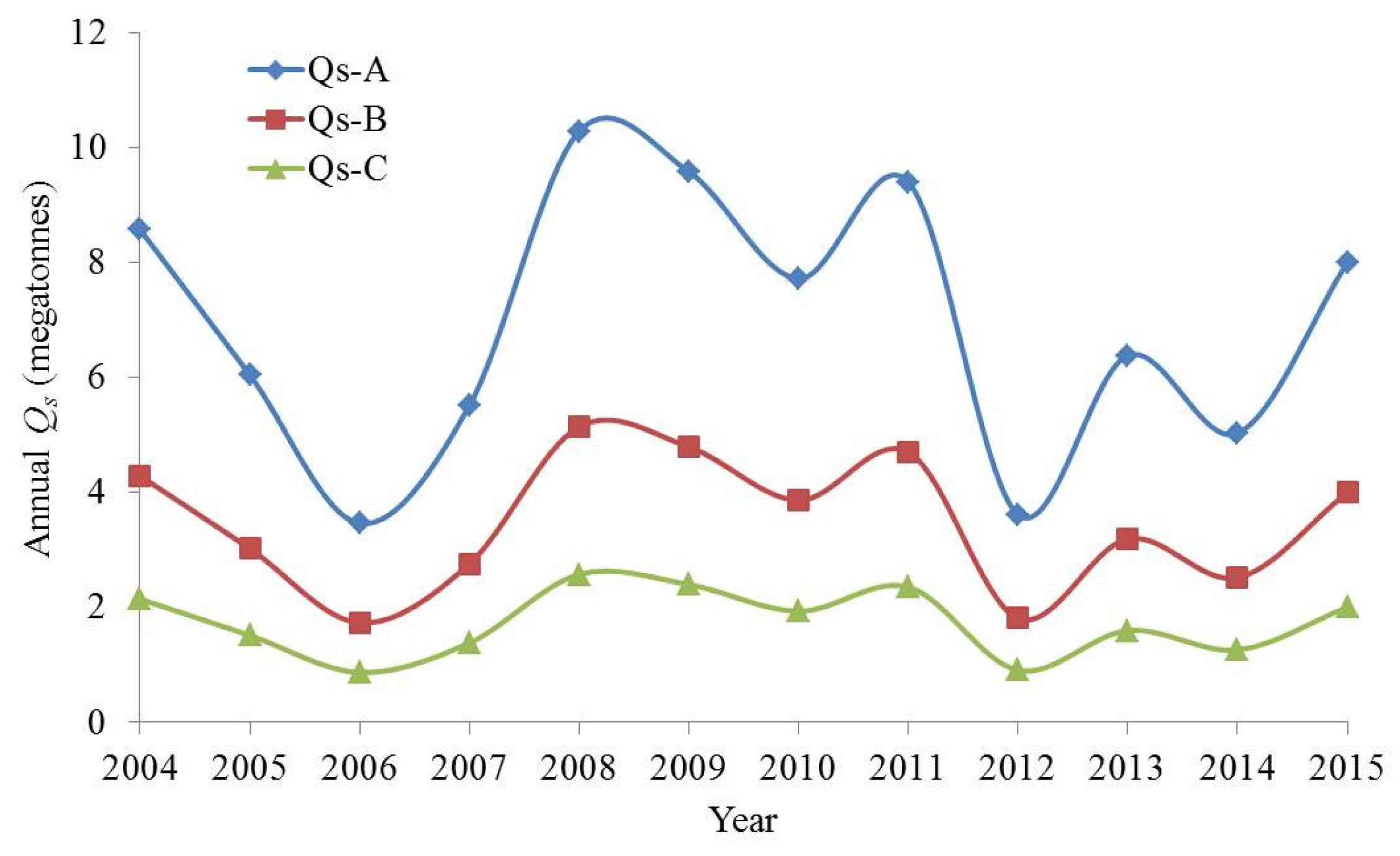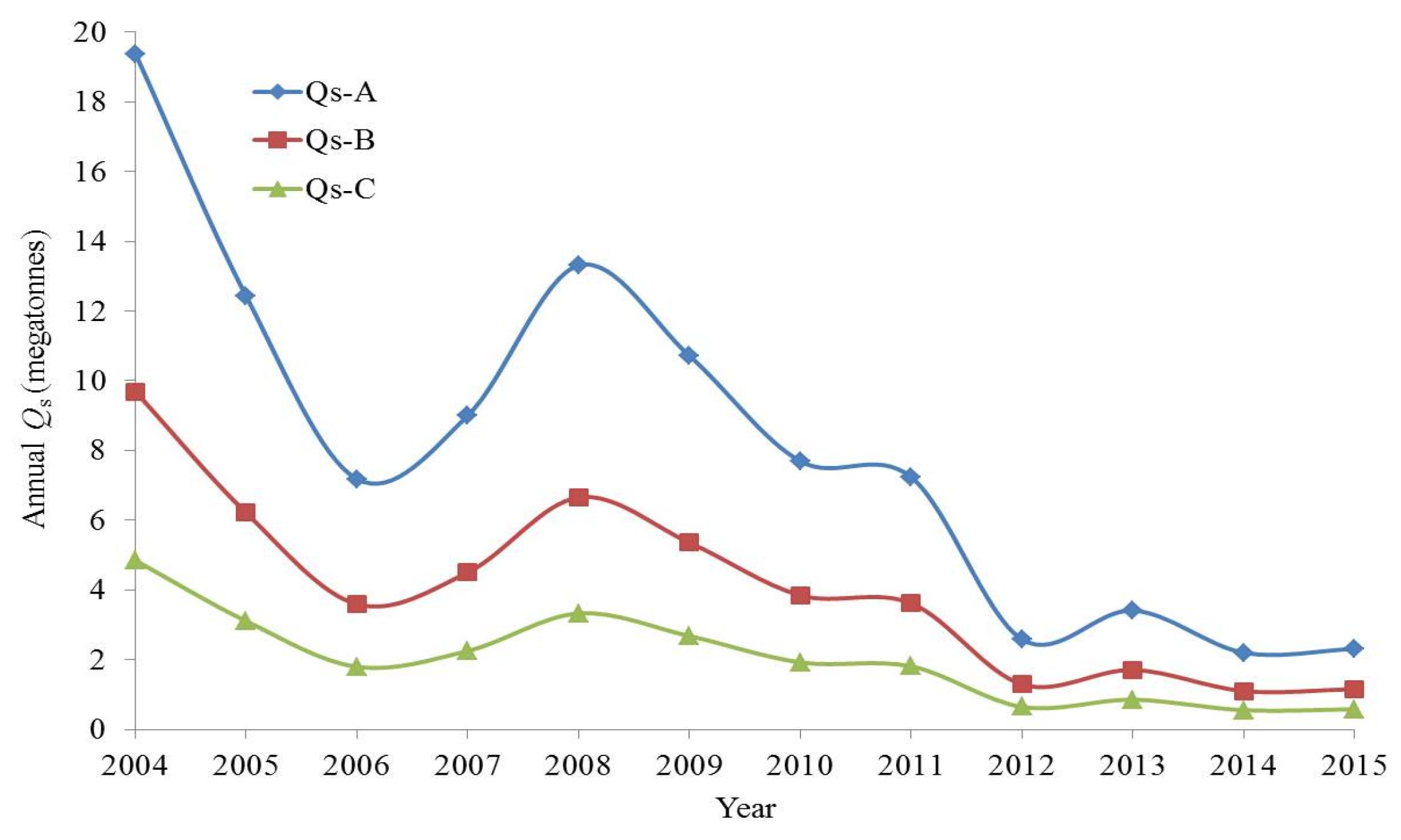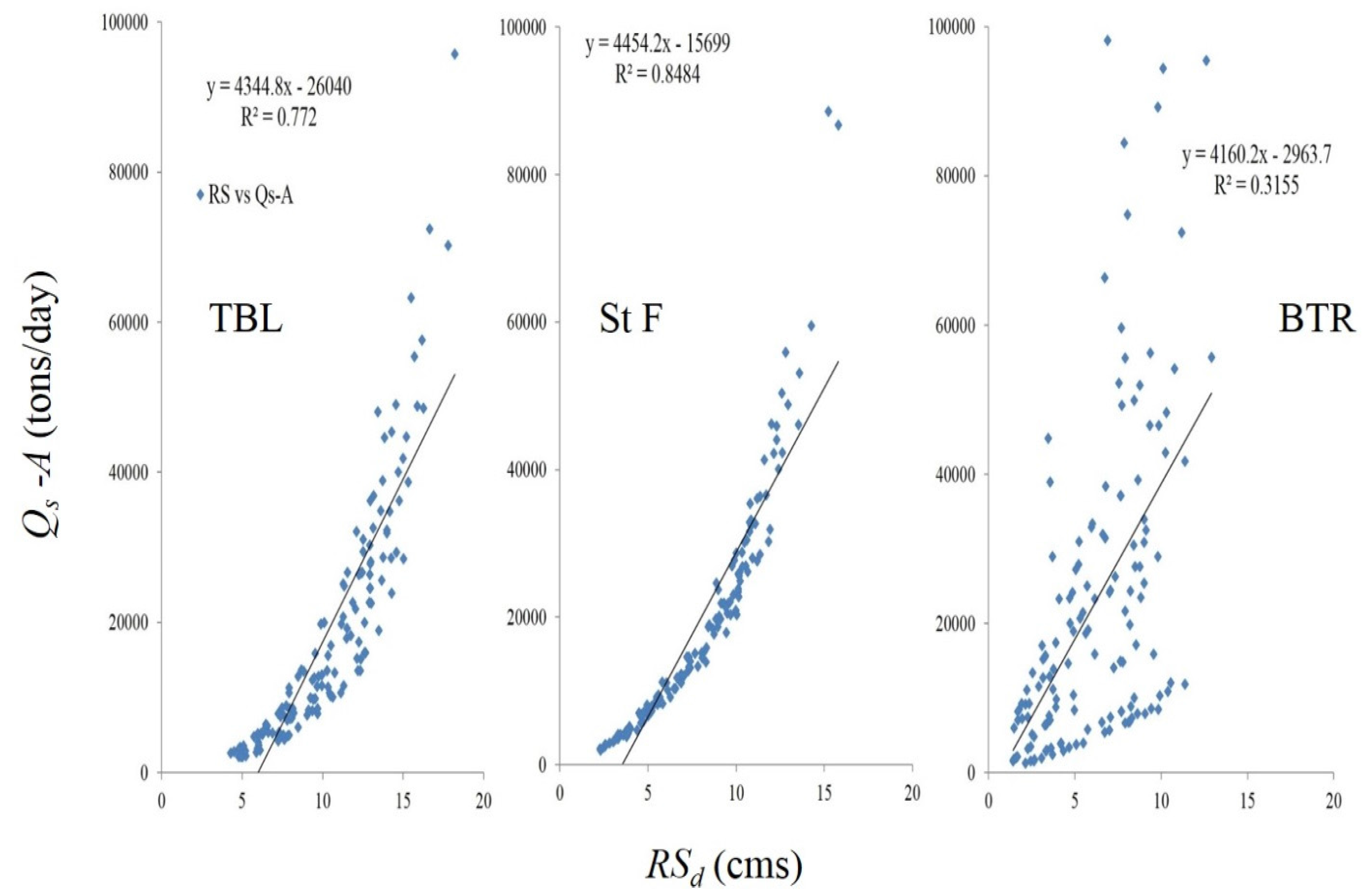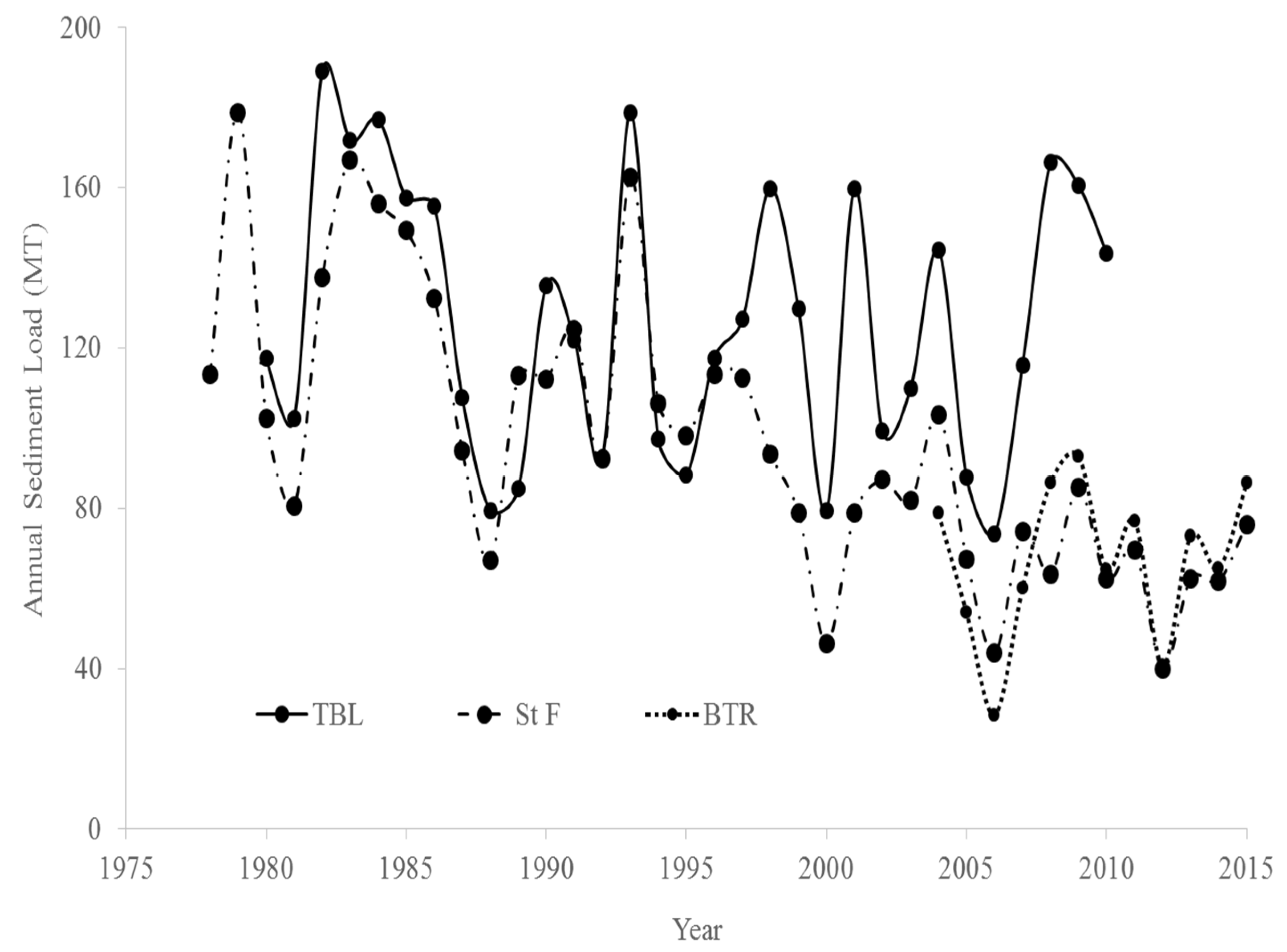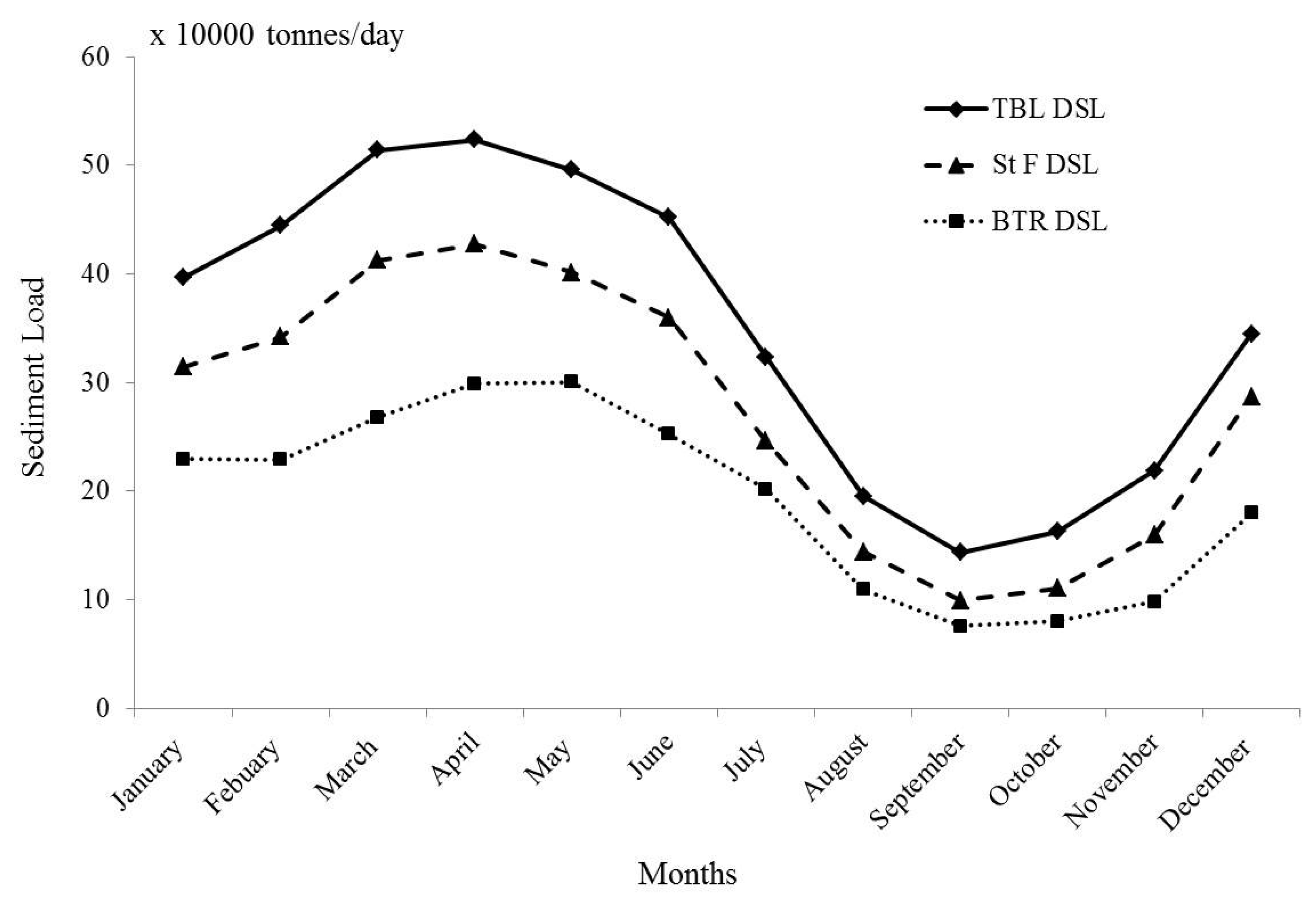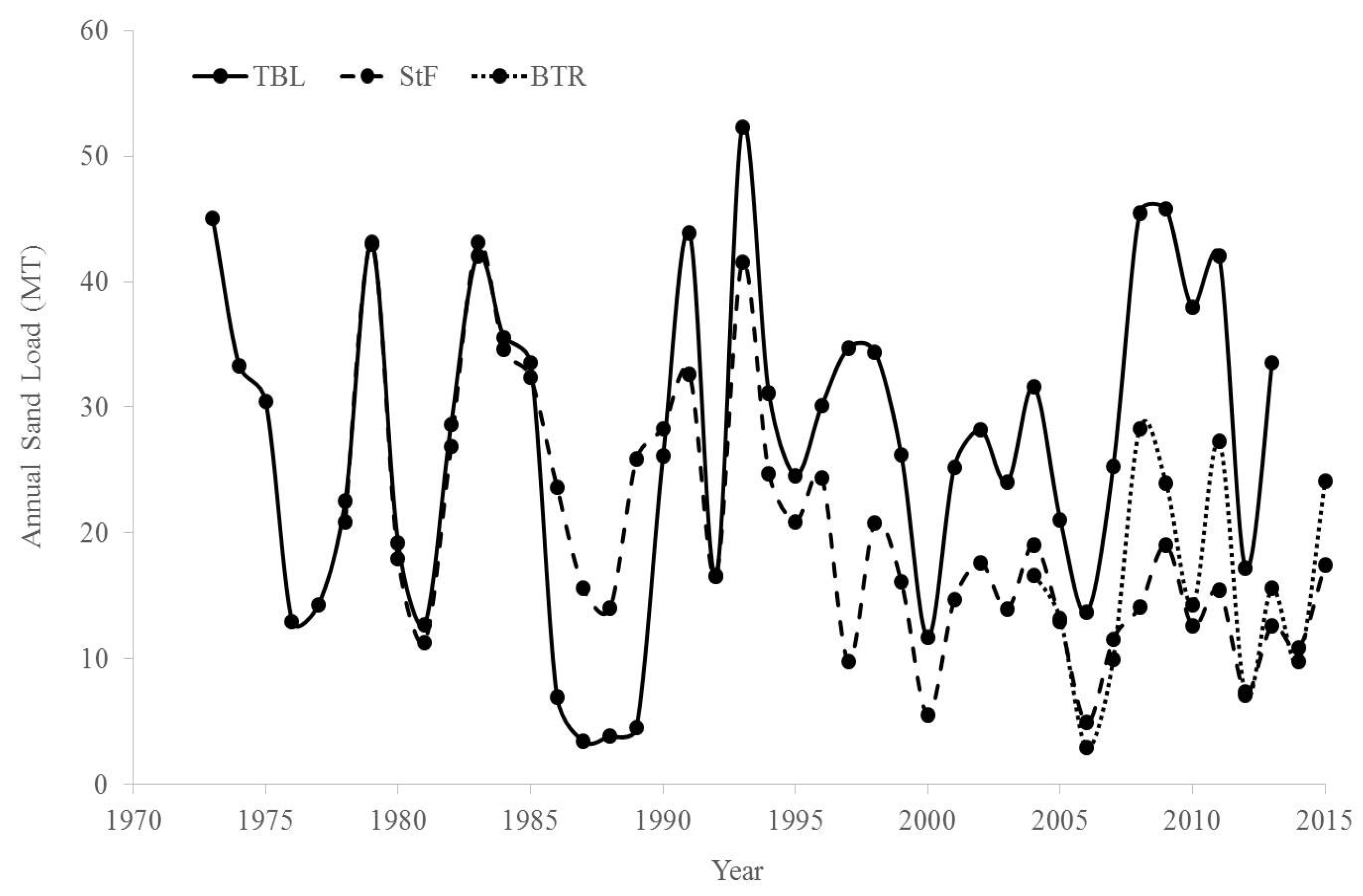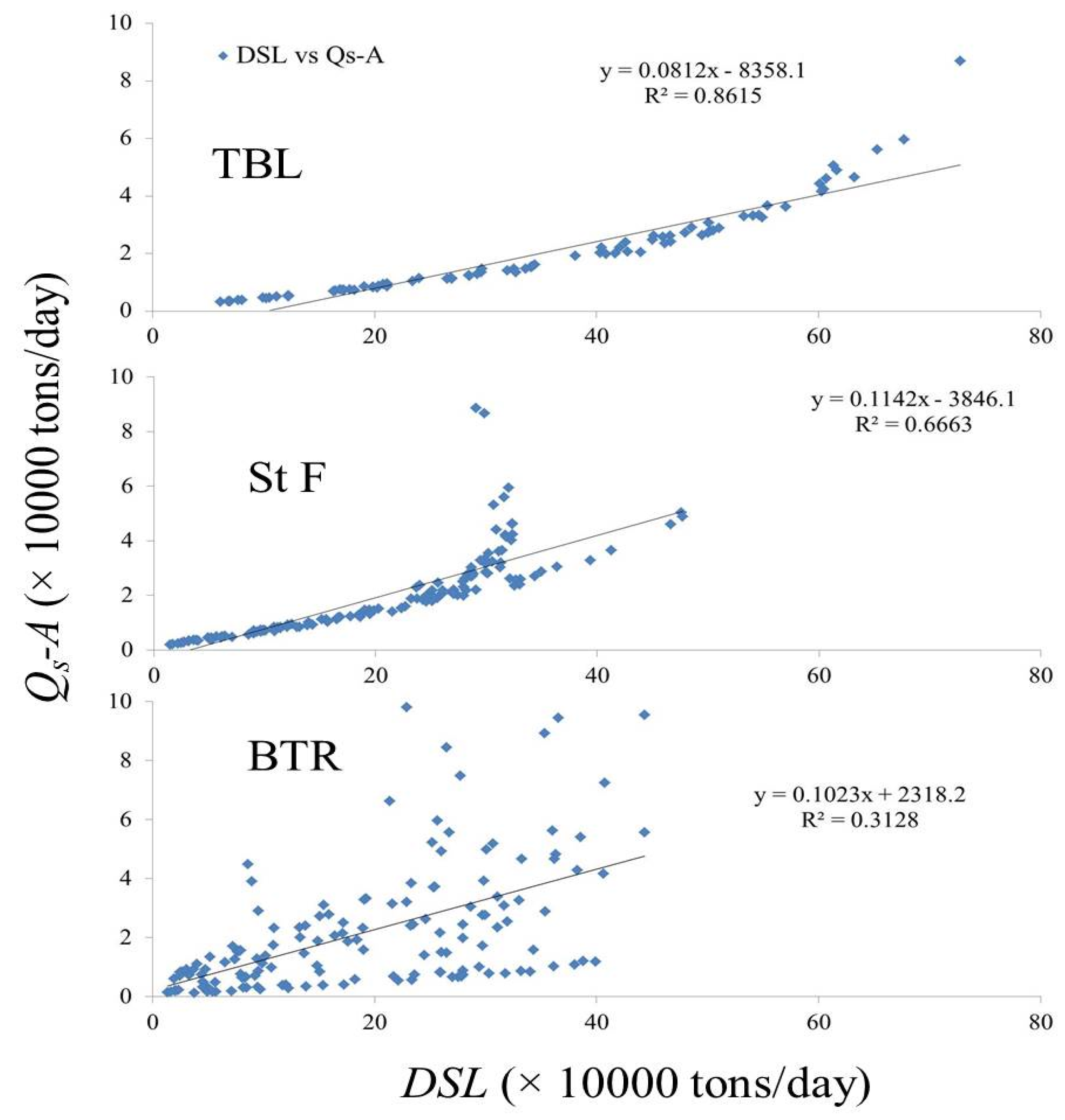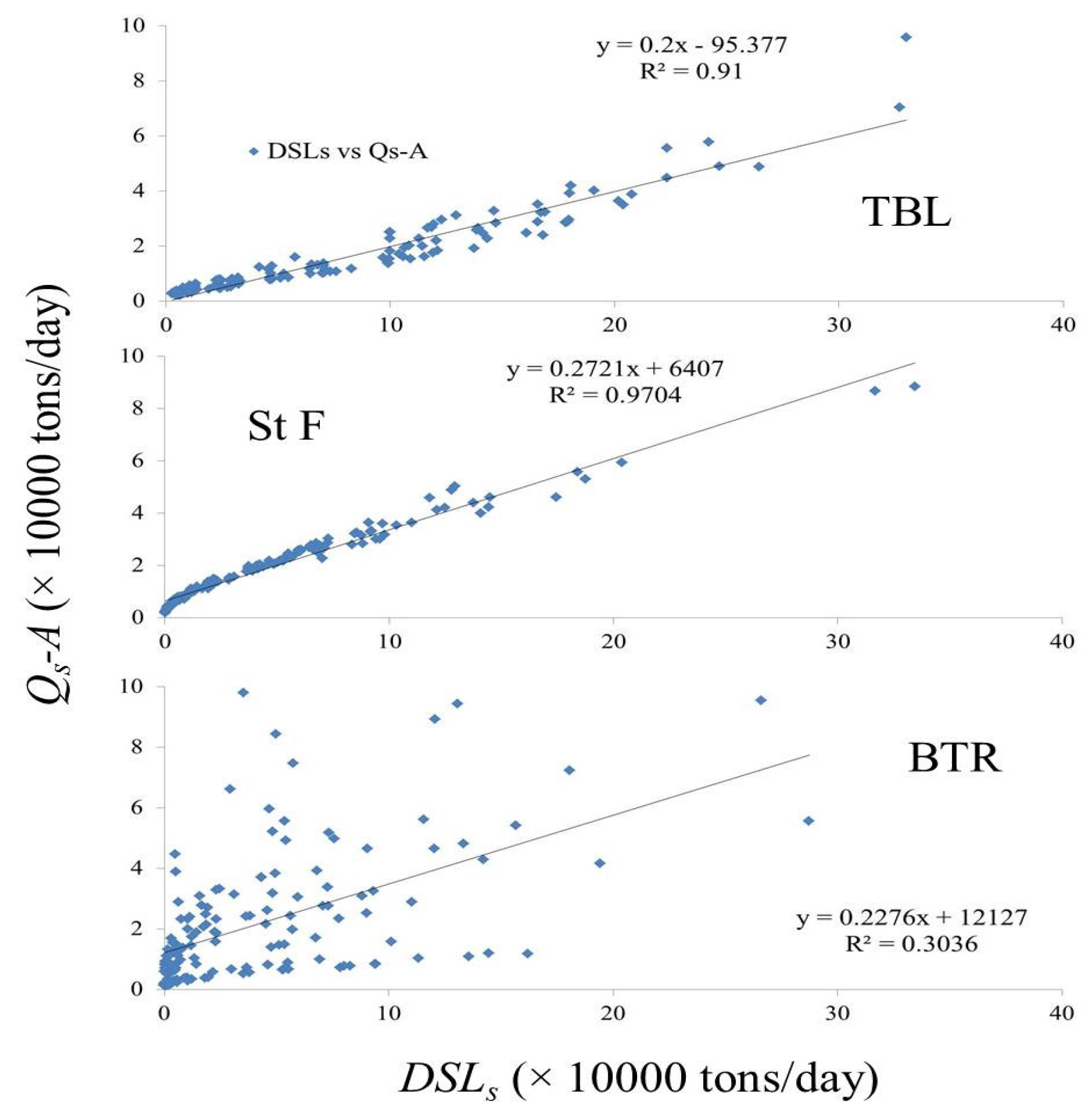4.1. Spatial and Temporal Variation in Bedload and Suspended Load along the LmMR
We found gradual increase in estimated bedload transport rates (
Qs) from Tarbert Landing to Baton Rouge during 2004–2015. In addition, the 12 years showed significantly higher
Qs at Baton Rouge and lower and nearly equal
Qs at Tarbert Landing and St Francisville for all grain sizes. We further found increase in
Qs with increase in riverbed elevation and decrease in cross-sectional area and grain-sizes at all locations. Therefore, we suggest that lower cross-sectional area (based on lower river widths), higher bed elevation and finer bottom sediments could have contributed to higher
Qs at Baton Rouge as compared to Tarbert Landing and St Francisville. The estimated daily river widths at Baton Rouge were at least 400 m less than the widths at Tarbert Landing and St Francisville in all river stages. Similarly, riverbed elevations for each year at Baton Rouge were at least 8 and 6 m higher than the corresponding riverbed elevations at Tarbert Landing and St Francisville respectively. Demas and Curwick [
58] noted that particle size of coarser sediments proximate to the river-bottom decreased gradually from Tarbert Landing to the Bonnet Carre Spillway (about 163 km downstream of Baton Rouge). Similarly, higher
Qs in lower
CSAs can imply that bed load movement can speed up in smaller cross-sectional profiles across rivers due to the clustered nature of bed materials. In larger cross-sectional profiles bed materials are probably more scattered, thus reducing the bedload movement. Daily
Qs increased almost linearly with daily river discharge and daily river stage at Tarbert Landing and St Francisville, but the trend was nearly unnoticeable at Baton Rouge. The bedload relationship with river discharge and stage at Tarbert Landing and St Francisville indicated that finer bed materials moved rapidly during higher river discharge and stage. However, bigger sized bed materials were probably difficult to transport especially during the low river stages in low discharge regimes. Also, proximity of low flows to the riverbed probably lowers their force in the bed materials, while higher flows can exert substantially more force in the materials [
59,
60]. However, substantially higher bed elevation at Baton Rouge probably negated the linear effects of discharge on bedload transport at this location. Furthermore, the river bed elevation increased at Tarbert Landing but decreased at Baton Rouge from 2004 to 2015 (1.95 m in 2004 increased to 2.04 m in 2015 at Tarbert Landing; 10.1 m in 2004 decreased to 9.9 m in 2015 at Baton Rouge), which may have caused continuously increasing bedloads at Tarbert Landing and decreasing bedloads at Baton Rouge during 2004–2015. However, the effects of river bed elevation were not evident on temporal bedload trends at St Francisville.
Subtle temporal variability in suspended loads (during overlapping periods) was found between the lower two locations (St Francisville and Baton Rouge) along the LmMR reach. Total annual sediment loads (
SL) and sand loads (
SLs) at both sites differed only by about 3 and 35 MT respectively during 2004–2015, with higher annual
SL at St Francisville and higher annual
SLs at Baton Rouge (
Table 6 and
Table 7). These differences fell considerably within the error range for suspended loads (±18%), thus could be statistically neglected. Allison et al. [
38] in a recent study also reported similar proximate suspended loads at both locations, but for a very short period (2008–2010) (270.8 MT
SL and 53 MT
SLs at St Francisville; and 277.3 MT
SL and 82.5 MT
SLs at Baton Rouge). Suspended loads at both locations, however, were considerably lower than the previous reported loads at Tarbert Landing for the corresponding coinciding periods. The total
SL at St Francisville was lower than Tarbert Landing by about 843 MT during 1980–2010 [3929 MT at Tarbert Landing (reported by Rosen and Xu [
28]) as compared to 3086 MT at St Francisville (in this study) (
Table 6)]. Similarly, total
SLs at St Francisville was lower than Tarbert Landing by about 253 MT during 1978–2013 [979 MT at Tarbert Landing (reported by Joshi and Xu [
31]) as compared to 726 MT at St Francisville (in this study) (
Table 7)]. In addition, the total
SL at Baton Rouge was lower than Tarbert Landing by approximately 427 MT during 2004–2010 [891 MT at Tarbert Landing (reported by Rosen and Xu [
28]) as compared to 464 MT at Baton Rouge (in this study) (
Table 6)], while total
SLs at Baton Rouge was lower than Tarbert Landing by about 155 MT during 2004–2013 [314 MT at Tarbert Landing (reported by Joshi and Xu [
31]) as compared to 159 MT at Baton Rouge (in this study) (
Table 7)]. The seasonal trends in
DSL and
DSLs in these locations were identical to the trends of total and annual suspended loads i.e., noticeably higher average
DSL and
DSLs during each month at Tarbert Landing as compared to those of nearly similar monthly loads at St Francisville and Baton Rouge, respectively. Such notable reductions in suspended loads from upstream to downstream locations along a river stretch over one to four decades can imply that substantial sediment flow is likely to be restricted for long time periods by major artificial structures built at the upstream site.
Aforementioned trends in suspended loads at the three locations quantifiably support the findings made by Joshi and Xu [
36] that the first 20–25 km LmMR reach below ORCS, covering Tarbert Landing and Red River Landing has experienced sediment deposition during the last three and half decades. Also, nearly equal suspended loads at St Francisville and Baton Rouge (during overlapping periods) support another of their conclusion that the reach from Bayou Sara (which is near St Francisville) to Baton Rouge experienced sediment erosion over the last three decades. Three factors that may have contributed most to the higher suspended loads at Tarbert Landing include: (1) diversion of ~25% of LmMR flow to the Atchafalaya River at the Old River Control Structure (ORCS) (~10 to 15 km upstream of Tarbert Landing) from 1963 [
61] which may have reduced water velocity near Tarbert Landing due to its proximity to the ORCS and aided in settling down suspended sediments; (2) three channel bars near Tarbert Landing which could retain riverine sediments especially during major floods, as found by Horowitz [
29], Wang and Xu [
62], and Wang and Xu [
35]; and (3) coarser bottom sediments at Tarbert Landing than those of St Francisville and Baton Rouge, as documented by Demas and Curwick [
58] and Horowitz [
29].
We found substantial decline in average annual
SL and
SLs at St Francisville after 1993 (the Mississippi River flood year). Annual
SL and
SLs at St Francisville averaged approximately 124 and 27 MT/year respectively during 1978–1993, while they averaged about 78 and 15 MT/year during 1994–2015 experiencing a decline of 46 and 12 MT/year, respectively post-1993. Previously, Horowitz [
29] noted nearly equivalent decline of 39 MT/year in annual
SLs at St Francisville during 1994–2007 as compared to 1981–1993. Sharp declines in the suspended loads at St Francisville post 1993 may have been caused by long overbank sedimentation followed by overbank floods along the upper and middle Mississippi River reach in 1993. Benedetti [
63] reported that the 1993 flood left 30–80 mm of silty fine sand on the floodplains of Upper Mississippi River from Minneapolis, Minnesota to St. Louis, Missouri. Similarly, Gomez et al. [
64] noted that the 1993 flood caused <4 mm of vertical accretion on leveed and unleveed floodplains along a 70-km reach of the Mississippi River near Quincy, Illionis. Gomez et al. [
65] examined the river reach between St. Louis and Thebes (approximately from the confluence of the Missouri and Mississippi Rivers to the confluence of Ohio and Mississippi Rivers) and concluded that several levee breaks along this reach could have been caused by sediment and circumjacent sand deposits from the 1993 flood. The overbank sedimentation could have removed substantial stored bed/suspended sediments in the reach and eliminated several SSC sources for the LmMR reach [
66]. There were no sediment records available to find the effects of 1993 flood on Baton Rouge suspended loads; however, we did not observe any significant trend in annual
SL and
SLs at this site during the last decade. Even the LmMR flood in 2011 did not seem to make a significant impact on the suspended loads at Baton Rouge, since there was negligible difference in average annual
SL and
SLs during the two periods: 2004–2011 (pre-2011 flooding) (mean annual
SL and
SLs = 67.7 and 17 MT respectively) and 2012–2015 (post-2011 flooding) (mean annual
SL and
SLs = 66.2 and 14.1 MT respectively). These intra-location pre- and post- flooding suspended load trends at St Francisville and Baton Rouge indicate that floods probably have substantial impacts on suspended loads for longer periods, while negligible impacts for shorter periods.
4.2. Relationship between Bedload and Suspended Load in the LmMR
Our monthly averages of daily bedload rates (
Qs) along the LmMR showed linearly increasing trends with monthly averages of daily suspended sediment loads (
DSL) and daily suspended sand loads (
DSLs) at Tarbert Landing (during the corresponding matching periods: 2004–2010 for
Qs–
DSL trends and 2004–2013 for
Qs–
DSLs) and St Francisville (during 2004–2015), respectively (
Figure 17 and
Figure 18). However, monthly
Qs showed more scattered trends with monthly
DSL and
DSLs respectively at Baton Rouge (during 2004–2015) (
Figure 17 and
Figure 18). These relationships were noted down for representative grain size of 0.125 mm and were exactly same for other grain sizes of 0.25 and 0.5 mm. The trends of
Qs with
DSL,
DSLs, river discharge and river stage (see
Section 3.1 for the latter two) possibly imply that bedload is more dependent on suspended load (specially suspended sand load), river discharge and river stage in upstream river locations with shallower beds, while the dependence gradually decreases as the river moves downstream and the bed elevation increases continuously.
Total and annual bedload rates (
Qs) for grain sizes 0.125, 0.25 and 0.5 mm at Tarbert Landing were about 4, 2 and 1% of the suspended sediment load and 18, 9 and 4.5% of the suspended sand load respectively during 2004–2010 (matching period for both loads at Tarbert Landing) (
Figure 19). Furthermore, total and annual
Qs at St Francisville for the aforementioned grain sizes were respectively about 10, 5 and 2.5% of its suspended sediment load and 53, 26.5 and 13% of its suspended sand load during 2004–2015 (matching period for both loads at St Francisville) (
Figure 19). Finally, the total and average annual
Qs at Baton Rouge for these grain sizes were approximately 12, 6 and 3% of its suspended sediment load and 50, 25 and 12.5% of its suspended sand load respectively during 2004–2015 (
Figure 19). Most of these values were within the ranges of percentage of bedload in suspended sediment (1% to 10%) and suspended sand load (10% to 33%) noted by previous studies ([
7,
8,
9]; see
Section 1). However, the only noticeable outliers in this regard were substantially higher percentage of
Qs in suspended sand load of St Francisville and Baton Rouge for grain size of 0.125 mm. These higher ranges were likely because of higher bed elevation at these two locations, gradually decreasing grain sizes from upstream to downstream in the LmMR (as explained in first paragraph of
Section 4.1) and substantially lower suspended sand loads in both locations as compared to the upstream location at Tarbert Landing (see
Section 4.1).
The findings for bedload transport in this study are opposite to the trends found for total suspended load along the LmMR. Apart from the probable reasons listed for corresponding trends in both, the contrasting differences could also be possible because suspended loads were estimated from sediment/sand-water discharge rating curves, while bedload transport rates were quantified using the concept of boundary and critical shear stresses and pre-studied sediment transport equations. Nittrouer et al. [
40] found opposite spatial trends in
Qs than the findings of this study along the LmMR reach (i.e., gradual increase from Baton Rouge to Tarbert Landing) but only in specific river discharges limited to 11,750 and 17,500 cms. They estimated negligible differences in
Qs during high flows throughout the reach (from Tarbert Landing to Baton Rouge). The differences in the
Qs estimates of the two studies could be because they considered back water flows in the LmMR which were ignored in this study.
The total sediment supply (bedload + suspended sediment load) for all grain sizes during the overlapping period of 2004–2010 at all locations was highest at Tarbert Landing (931, 911 and 893 MT for grain sizes of 0.125, 0.25, 0.5 respectively), and decreased gradually at two downstream locations along the LmMR (550, 525 and 500 MT at St Francisville and 544, 504 and 485 MT at Baton Rouge for the three aforementioned grain sizes respectively) (
Figure 19). Furthermore, for the two locations downstream of Tarbert Landing, the total sediment loads were a little higher at Baton Rouge than St Francisville for the grain sizes of 0.125 and 0.25 mm respectively (904 MT for a grain size of 0.125 mm and 855 MT for 0.25 mm at Baton Rouge as compared to 893 for 0.125 mm and 850 MT for 0.25 mm at St Francisville) during 2004–2015 (the matching period for both locations) (
Figure 19). For the remaining grain size of 0.5 mm the total suspended loads were almost equal at both locations during the 12-year period (~830 MT) (
Figure 19).
4.3. Sediment Trapping in the LmMR
From this analysis, it seems likely that the first 20–25 km reach of the LmMR just below its diversion to the Atchafalaya River (covering Tarbert Landing) has been a major sediment trapping location over the last four decades. Lower bedload transport along this reach during the last decade suggests that bedloads possibly acted as sources of sand loads near the riverbed because both loads can be intermixed especially in laterally migrating sand dunes under low and medium flows [
40,
67,
68]. However, the sand particles possibly get trapped in the sediment channel bars present along this reach. Wang and Xu [
35] noted high three-decadal sediment accumulation in the three sediment bars present at 18, 24 and 26 km downstream of the Old River Control Structure respectively (total sediment load of 36 million tons during 1985–2013). This may have been the primary reason of lower proportion of sand outflow between Tarbert Landing and St Francisville as compared to sediment outflow over the last three and half decades (mean annual
SL at Tarbert Landing was 27% higher than St Francisville during 1980–2010, while mean annual
SLs was about 20% higher during the same period). The total sediment supply at Tarbert Landing was higher than St Francisville and Baton Rouge during 2004–2010 despite its lower
Qs during the same period (
Figure 19;
Section 4.2). This observation can probably imply that the sediment trapping capacity gradually reduces downstream along the LmMR reach particularly below its uppermost 20–25 km stretch.
The importance of suspended loads for restoration of the MRDP has been previously well documented [
32,
33,
34,
69]. Continuous movement of suspended load is critical in long-term delta building and restoration processes [
34,
70]. Therefore, sediment management in the LmMR should focus on increasing outflow of suspended loads trapped in the uppermost 20–25 km reach to the downstream locations (especially to St Francisville) which can further help in planning and executing sediment diversion projects along the river subsequently. In addition, the bed and suspended load estimates in this study also indicate that significant spatiotemporal variability can occur in sediment supplies from upstream to downstream reaches of highly engineered alluvial rivers on a global scale. Information on long-term sediment supplies along several different sediment-starved rivers can benefit the river management practices.
4.4. Uncertainty and Constraints in Bedload Estimation
The estimation of bedloads (
Qs) in this study is one of the few attempts in quantifying daily
Qs at multiple sites along a large regulated alluvial river for more than a decade. Most previous studies quantifying
Qs along the LmMR have applied measurements of bedform heights using multibeam echosounder surveys in their two or three dimensional models [
11,
41,
71,
72]. Since, we did not have such measurements; we only used Engelund-Hansen equation primarily developed for and tested in laboratory conditions. Furthermore, we did not have site-specific bedload measurements like suspended sediment concentrations to validate the estimates of bedload transport rates along the LmMR. This is a main uncertainty in the bedload estimates of this study.
There was a need to estimate annual riverbed elevation and other daily variables such as flow velocity, river width and cross-sectional area at the three sites for quantifying daily Qs from Equation (1). The calculations for all these parameters were subjected to potential errors. Riverbed elevations (Rebed) were only available for 2004 and 2013 at all locations; therefore, Rebed had to be interpolated for the period of 2005–2012 and of 2014–2015. In interpolation, the difference in Rebed for 2004–2013 was only considered as overall increase or decrease, but any specific increase or decrease in Rebed within the years between 2004 and 2013 was ignored. The uncertainty for average flow velocity was dependent on the errors for cross-sectional area. The calculation of daily cross-sectional area was subjected to the potential errors in estimating river width through earth explorer and arc map tools. Also, the daily cross-sectional areas at all locations were probably overestimated because the river channel was considered as rectangle and the cross-sectional areas were measured as a product of river depth and river width. This study could not find a method to measure the cross-sectional area such that it exactly coincided with the half oval shaped riverbed cross-section.
Despite the above-mentioned uncertainties, this study provides plausible estimates of bedload rates that are within previously reported
Qs estimation ranges, i.e., 1% to 10% of suspended sediment load, or 10% to 33% of suspended sand load. A ±24% margin of error is given for all
Qs estimates (see
Section 2.7) to properly document estimation performance.

